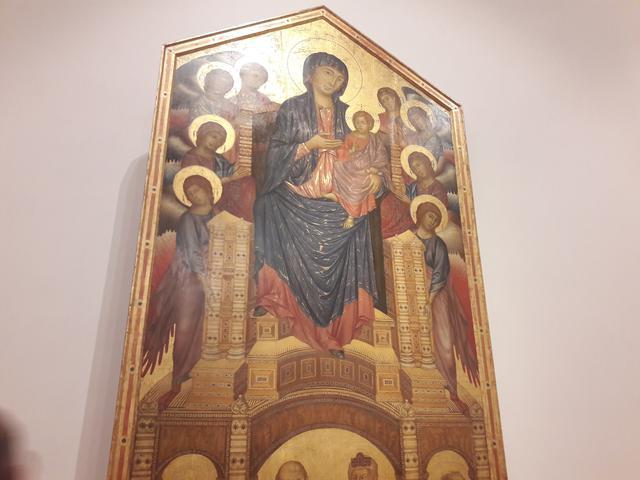Holy Trinity Majesty

The painting was originally hung in the Vallombrosian church of Santa Trinita in Florence and since the 16th century has been recorded as the work of Cimabue, the most important 13th-century Florentine painter who, in addition to working in Tuscany, was also present in Rome. Assisi and Bologna.
Seated on a grandiose and imposing ivory throne, with an articulated architectural form, the Virgin Mary uses her right hand to point to her son, whom she holds, according to the Byzantine model of the Virgin Hodegetria, that is, the one who shows the way . to salvation. Dressed as an ancient philosopher, Jesus blesses and holds a rolled scroll, which is perhaps the scroll of the law. The clothing worn by Mary and her son features beautiful gold decoration known as damascene, a feature of traditional Byzantine painting, which was very fashionable in medieval Italian painting. Around them are eight angels with splendid multicolored wings, gently raising the throne. What is quite unusual for the iconography of the Enthroned Virgin and Child is the representation, under the throne, of several Old Testament prophets (from left to right: Jeremiah, Abraham, David and Isaiah) holding phylacteries with writings of the Saint Scriptures, alluding to the mysteries of the Incarnation and Virginity of Mary.
The painting stands out for the boldly elegant decorations, also seen in the background, which is finely decorated with geometric motifs etched in the gold. Although the dates of this work have been the subject of much discussion, there is a tendency to date the Santa Trinita Maestà to the latter part of Cimabue's career. In this masterpiece, the complex division of space used for the throne, the folds of the clothing, the modulation of chiaroscuro and the kind expressions of the Virgin and the angels seem to be affected by the naturalism that distinguishes younger artists, such as Duccio. Di Buoninsegna and, above all, Cimabue's own student, Giotto.
© Tourblink